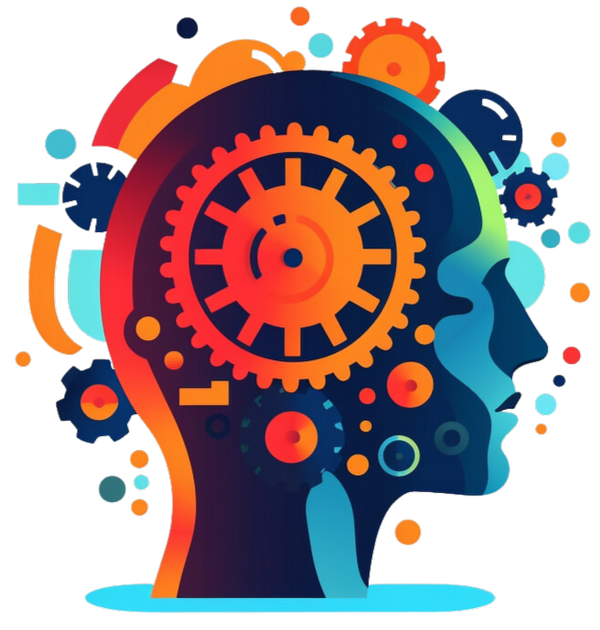
ADHD thinking: sky bridge and stumbling block
Share
"Yes, the polar ice caps are probably melting because of climate change. Then the polar bears are drifting into the sea on broken ice floes. Did you know that there are no polar bears at the South Pole, and no penguins at the North Pole? And penguins, by the way, burn well. Desperate polar explorers have thrown them into fires to avoid freezing to death..."
Et voilà. Divergent thinking from someone with ADHD . Interesting, isn't it? Except you actually wanted to talk about climate change. And now you're mentally sitting around a large fire with two half-frozen polar explorers named Svensson and Knutsson, the smell of burnt penguin fat in your nostrils.
It's not always easy to talk to someone with ADHD. But it's very easy to "get it."

1. Divergent Thinking: Definition and Meaning
Divergent thinking is a creative, nonlinear, and flexible way of thinking that generates a multitude of ideas, concepts, and possible solutions to a problem or issue. Unlike convergent thinking, which aims at logical and linear conclusions, divergent thinking promotes the emergence of new ideas and innovations. It is a key component of creativity and problem-solving.
This type of thinking can be triggered/deepened by methods such as brainstorming, mind mapping, creative writing, analogies and metaphors. Or you might have a brain with ADHD . Then you just have to sit down at a table and draw/write down everything that comes to mind. In about 15-30 minutes you will have a huge mind map in front of you, with "climate change" in the middle, for example. "Ecosystems" shouldn't be far from it. With "North Pole" and "South Pole" you have also marked out the places where the largest ice masses are melting. In the past they were much larger. We know this thanks to polar research.
Well, suddenly Svensson and Knutsson aren't sitting as far away as they were before. They've just experienced how people with ADHD think, connect, and reason (most of the time).
Examples of convergent vs. divergent thinking:
Convergent thinking: "When solving a mathematical equation, there is only one correct answer, and by systematically applying formulas and rules, one can find it."
Divergent thinking: "To develop new ideas for a product, we brainstormed as a group, with everyone contributing a variety of unconventional and creative suggestions. We can implement three of them."

2. ADHD and divergent thinking
Various psychological tests and studies have shown that people with ADHD often exhibit a higher degree of divergent thinking than their peers without ADHD. They tend to explore alternative ways of thinking and find less conventional solutions to problems . This way of thinking can be very useful in professional life, for example, when problems are too complex to consider all relevant factors for a good solution.
It's precisely in these cases that new approaches, completely different from old solution models, can lead to a breakthrough. Sometimes simply a satisfactory first step. Or a classic "workaround." When we dream, we all think in highly divergent ways. And in various cases, dreams have led to scientific breakthroughs.
In our so-called VUCA world, which is changing rapidly – and in which challenges are constantly evolving – divergent thinking can prove its worth. This approach breaks – unpredictably – with traditional, linear patterns by seeking the improbable , questioning supposedly immutable conditions (axioms), and allowing for mental leaps and diffuse associations. Even "wrong" lines of thought or seemingly unfeasible solutions can represent valuable steps toward insight, as long as they ultimately lead back to the central theme.
For example, have you ever wondered what you could do to completely ruin your current romantic relationship? After all, you're not crazy? Too bad. Because this very thought experiment ("devil's advocate") is successfully used in business and science to find good solutions. To benefit from it, you simply need to replace the phrase "can do" with "better avoid." And if you eliminate some destructive behaviors in your interactions with others, you'll have already removed an enormous number of obstacles to good relationships and friendships.

3. Benefits of divergent thinking
a) Creativity and innovation: Divergent thinking is crucial in many professions, especially in creative industries such as design, advertising, and media. People with ADHD are particularly well-suited to using their creative skills to develop innovative ideas and solutions ("out-of-the-box" approaches).
b) Teamwork: Their divergent thinking can help people with ADHD make valuable contributions to group discussions. Their ability to contribute unconventional, uncensored perspectives thus promotes the innovativeness and adaptability of teams, especially during brainstorming sessions. An important success factor in times of major change.
c) Problem-solving: In professional life, people with ADHD can benefit from their ability to find creative and unusual solutions to complex problems entirely on their own. This makes them valuable employees in professions that require resourceful problem-solving and critical reflection/analysis, such as research, technology, or consulting.
d) Flexibility: People with ADHD are often better able to adapt mentally to changes, as they quickly develop alternative solutions, especially under pressure. The seemingly unsolvable and complicated also greatly motivates them. Boredom, on the other hand, is psychological death for them. This combination is invaluable in a fast-paced, artificial intelligence (AI)-driven working world.

4. Disadvantages of divergent thinking
a) Word-splitting/excessive conversations: Those with ADHD often get the impression that they are prone to double-talk, quibbling, or distorting facts. This is often the case, but it's very rarely intentionally manipulative, since ADHD actually requires the processing of many thoughts at once, while stimulus filters in the frontal lobe function less effectively. Furthermore, the often weaker working memory performance makes it difficult to spontaneously and accurately recall things that happened recently ("Where's my damn sweater?").
b) Misunderstandings/Tensions: Due to their impulsive, erratic thinking, people with ADHD can sometimes appear unstable and inconsistent. This often leads to outsiders doubting the reliability/competence of those affected by ADHD. This, in turn, is perceived as very stressful (rejection, social exclusion).
c) Arrogant external appearance/conflicts: If thoughts arising from nonlinear thought processes are not explained to outsiders in a coherent/linear way, this often leads to conflicts. People with ADHD often cannot understand that their thought processes are not coherent to others. Due to their increased impulsiveness, they also react in a "snotty" or aggressive manner ("It's obvious that THAT is connected to such-and-such!" etc.).
d) Logical errors/generalization: Divergent thinking can and will lead to false conclusions if it is not accompanied by convergent—i.e., linear—thinking. A classic example are so-called conspiracy theories , in which pizzas, reptilians, child pornography, and, of course, the evil global elite are all suddenly in the same boat. People who perhaps don't even tidy their own rooms have quickly found the solution to third-world poverty. Or not. Because otherwise, their rooms would probably be tidy too (my own opinion. Room is messy. Which is why there are no instant solutions to world hunger in store).

5. Conclusion
Although ADHD presents challenges in everyday life, it also brings unique strengths. Divergent thinking, which is more pronounced in many people with ADHD, can be extremely beneficial both personally and professionally. However, it also presents pitfalls that can only be overcome with patience and peaceful communication (following questions, briefly summarizing, etc.) .
By recognizing and promoting the ability to think divergently , we can also help young people with ADHD to develop their creative talents – and later achieve success in these areas.
And otherwise, they could probably still become polar explorers. Because risk-taking and a thirst for adventure are clearly in the blood of people with ADHD...
